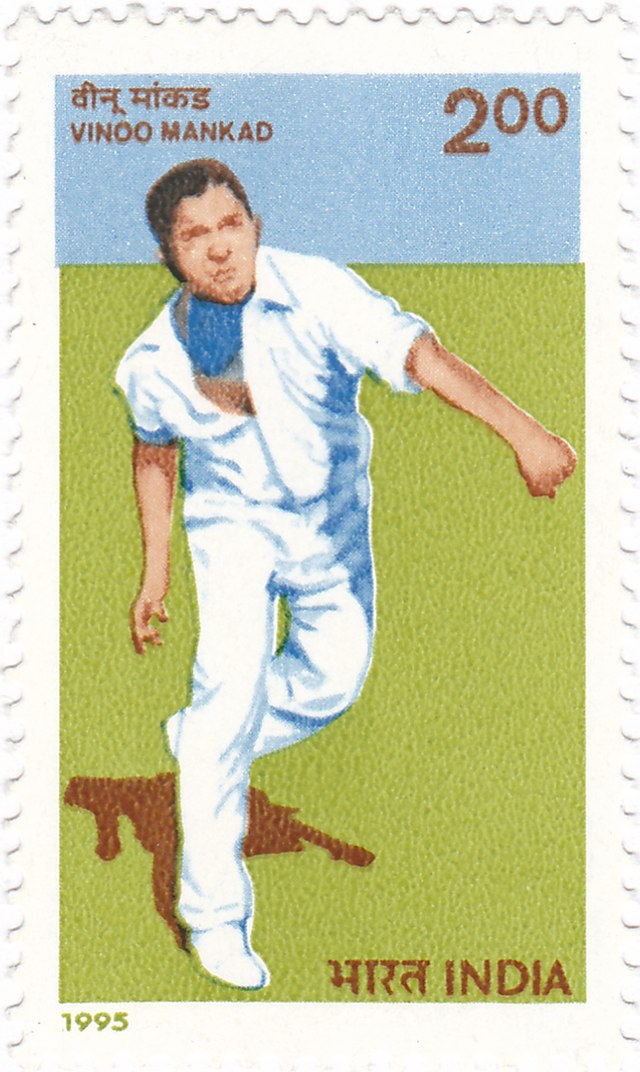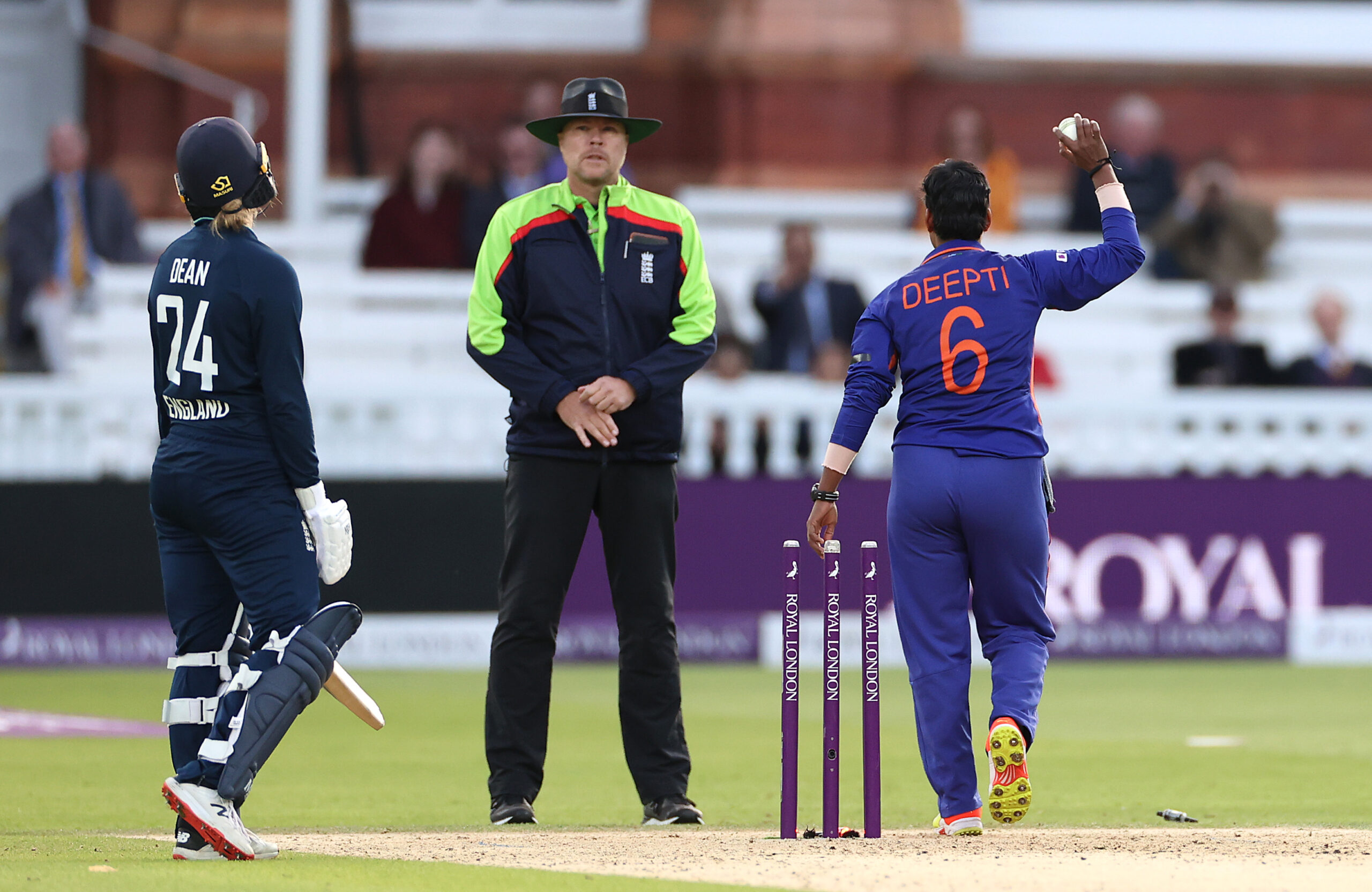To halt, or not to halt - that is the question.
Whether it's in the spirit of the game, or not, is still hotly debated, but as cricketing conservatives have been left to shake their heads, the controversial act of the ‘Mankad' has been officially ratified.
In September 2022, the act of running out non-strikers that prematurely creep from their crease was greenlit by the International Cricket Council. While previously deemed as “unfair play”, the choice to stop short and send those who jumped the gun for an early shower will now be recorded simply as a run-out. Slings and arrows, be damned.
But how did we get here?
While it has come to stoke bitterness, ambivalence and more fistfights than Caeser's Palace, for the uninitiated, the phrase ‘Mankad' goes beyond just that. It's an eponym.
When cricketing legacies are conjured, images of the game's finest are set in stone and cast in bronze. In Melbourne, both a grandstand and a statue pay tribute to the city's favourite son, the late, great Shane Keith Warne. Although trophies bearing the names Border, Hadlee and Muralitharan are fought for by the stars of today, the legacies of these cross-continental champions pale in comparison to the divisive tale of Mulvantrai Himmatlal Mankad.

Making the lengthy journey south to Australia, Mankad and his compatriots were soundly beaten throughout on their tour of the continent. But in facing Don Bradman's XI - a unit mere months away from being dubbed as ‘Invincibles' - the off-spinning opener took matters into his own hands in an effort to level a pair of playing fields.
With 889 runs at 38.65 and 61 wickets, Mankad's overall influence throughout the Australian summer was of an elite standard. Yet, when he halted during his run-up at the SCG to take dismiss Test opener Bill Brown during a tour game, the game of cricket was changed forever.
Reports from the day stress that the Indian all-rounder had repeatedly warned Brown, cautions that ultimately went unheeded before the fateful event that took on the bowler's name. They again fell on deaf ears when Mankad took Brown's wicket in the same fashion at the same venue just over a month later.
Historically, Australian crowds have never proven the most forgiving. But when the then 30-year-old whipped off Brown's bails after the Australian tried to “steal a march” during the 2nd Test, the Harbourside crowd instead voiced their approval, rather than hauling their guest over hot coals.

“Umpire Barlow unhesitatingly gave him out. Most of the crowd of 20,027 applauded, as if commending the bowler for his vigilance.”
This same applause was captured from further corners in the coming days, with several South Australians using the pages of The News broadsheet to stress that Mankad “more than satisfied the unwritten laws of sportsmanship” and that anyone chiding the spinner “showed gross ignorance of the laws of cricket”.
Still, debate raged in the press box as Brown wandered into the sheds just three balls shy of the day's conclusion. However, when the question was posed as to why Mankad had thrown the cat amongst the pigeons so late in the piece, the architect revealed that everything had unfolded according to plan.
Speaking to L. H. Kearney of The Courier Mail, Mankad stressed that as a left-arm bowler, he had a front-row seat to Brown creeping up the wicket.
“My reflective vision becomes affected, and my bowling concentration suffers,” Mankad told Kearney's Queensland readers.
“I warned Brown in Sydney not to leave the non-striker's popping crease until the ball had left my hand, but Brown ignored the warning.”
So why then if everything appeared rosy and all parties seemed satisfied does the action still have so many stumped today? Is it simply a question of culture, or are there more sinister elements at play?

In late September 2022, a touring Indian team once again found themselves back at Lord's Cricket Ground. With the last of three games in the balance, the ball was thrown to one of the world's greatest all-rounders. This time a right-armer.
After swatting their hosts by seven wickets and 88 runs respectively across the opening two fixtures in Hove and Kent, India's women had sewn up the series days before venturing to London. Yet, with a whitewash on the line, there would be no backward step from the tourists - just a halt at the crease.
As the dead-rubber at the home of cricket crept towards its conclusion, England, led by a rearguard stand from spinner Charlie Dean, had the hosts trailing by just 16 runs with over six overs to spare.
In her eagerness to cover tailender Freya Davies, Dean showed her hand, creeping from her crease in an effort to rotate the strike. But, apparently without warning, the English offensive came to a close as India's Deepti Sharma channelled her compatriot, ending the stand, the innings, and the series with a 'Mankad'.
Though fewer than 16,000 spectators saw these events unfold live at Lord's, word of the dismissal soon shot around the globe, bringing the same heated debate back to office water coolers and Twitter feeds.
With the game's creators and its most fervent followers involved in this latest contentious chapter, stark divides between styles and intentions were on show when English superstar Ben Stokes stood toe-to-toe with Indian commentary great Harsha Bhogle on the subject.
Harsha … bringing culture into peoples opinion over a Mankad? https://t.co/QNyY8K59kP
— Ben Stokes (@benstokes38) October 1, 2022
Is there a cultural divide at the heart of this eternal discourse?
The proclaimed "voice of cricket" certainly believes so, whether Stokes is willing to nibble or not. Still, these particular points of view, from these particular corners of the globe, are as on-brand as Stokes steering his side to victory in a white-ball final.
Uneven playing fields
Ever since the English landed in the port of Surat in 1608, India has been laid open to British influence. While this interference would only emerge as an official rule with the rise of the British Raj some 250 years later, England's tentacles of influence would play puppet master over the subcontinent until India's Parliamentary Independence was struck in 1947.

Even then, the scars of class implementation and adjoining social privileges are clear to see today on many Indian street corners or upper-caste tea parties.
For the English, cricket proved their most effective instrument of assimilation among the colonies. Their laws and lore reigned. They taught the game and then beat their subjects. Like missionaries in matching caps, only with the iconography of three stumps and not a cross.
Merchant sailors may have pressed the game of cricket on India's now-adoring masses, but it came with a cost.
One that the English, evidently, forgot to jot down.
At the time that Deepti dismissed Dean in September 2022, cricket's ambiguous laws failed to stipulate that the 25-year-old had no right to stop and prop. They did, however, claim that the English were still free to stare down their nose at their guests.
And though the rulebook has been altered from the copy that still sits behind glass in the Marleybone Cricket Club (MCC) Museum, the attitude of the ruling class who first penned the game's laws still clearly pervades the game.
Allegorically speaking, an argument could be made that the Deepti-Dean dismissal is a perfect example of class warfare in action. Not only do we have the morally superior ruling class seeking to control the narrative outside of their territory, but we also have the proletariat uprising; 'keeping the bastards honest' after summer upon summer on an unfair playing field.
With Dean playing the role of the ordained Englander, one with a divine, yet unwritten, right to roam, peeps from the subject with ball in hand are normally scoffed at. This scenario adds weight to why Deepti - reportedly - never warned Dean. She just took what she felt was hers.
If anything, this is a language that the English should understand.

Since Vinoo Mankad first made his name in Sydney over 75 years ago, a further 49 cases of contentious wickets at the non-striker's end have arisen across all forms of professional cricket.
Throw in a further nine warnings made at both the international and first-class level, and the mode of dismissal remains a viable one in the minds of many across the globe.
Yet, of this half-century of 'Mankads', how many of them have been delivered by the hand of an Indian cricketer?
| Format | Number of dismissals | Involving an Indian bowler | Percentage of total dismissals |
| Test | 4 | 1 | 25% |
| ODI | 4 | 1 | 25% |
| T20I | 1 | 0 | 0% |
| WODI | 1 | 1 | 100% |
| WT20I | 1 | 0 | 0% |
| First-class | 36 | 9 | 25% |
| T20 | 2 | 1 | 50% |
| W List A | 1 | 1 | 100% |
| Warnings | 9 | 4 | 44.4% |
| Total - including warnings | 59 | 17 | 28.8% |
| Total - excluding warnings | 50 | 13 | 26% |
During his days as Prime Minister of the United Kingdom, Benjamin Disraeli pressed that there are three kinds of lies: lies, damn lies, and statistics.
But with 12 full members and 92 associate members of the ICC family able to play a hand in amassing these cut-and-dried figures, having 26 per cent arise from just one country surely goes beyond the bounds of coincidence.
That number again reared its head in 2020 when India's controlling board earned US$405 million from the ICC's future-tours program, equating to 26 per cent of the sum total - by far and away the largest haul of any of the 10 Test-playing nations to share in the wealth.
The muscle of the Board of Control for Cricket in India (BCCI) has long been understood and parodied. However, with the rulebook re-written after a meeting of the MCC's Laws sub-committee, morphing 'Mankads' into run-outs, the subcontinental board's own tentacles of influence have helped turn the tables from their usual position.
Changing attitudes?
As a shorthand, the term 'Mankad' is understood by anyone that has ever sent a half-tracker to the fence, or been asked to stand idly at fine leg on a balmy afternoon.
Nevertheless, it remains one that has rankled even the finest to mark centre before the eyes of 1.3 billion compatriots.
"I was always uncomfortable with that particular dismissal being called 'Mankaded'," champion batsman Sachin Tendulkar said of the amended laws in September.
"I am really happy that it's been changed to run out. It always should have been run out according to me. So this is one good news for all of us."
So often compared to Bradman throughout his 200-Test, 463-ODI career, Tendulkar's honest appraisal aligns tightly with Bradman's own musings on Mankad, penned within his 1950 memoir, 'Farewell to Cricket'.
-
"For the life of me, I can't understand why [the press] questioned his sportsmanship. The laws of cricket make it quite clear that the non-striker must keep within his ground until the ball has been delivered. If not, why is the provision there which enables the bowler to run him out? By backing up too far or too early, the non-striker is very obviously gaining an unfair advantage."
Although hailed as a borderline demigod in Australian society, recent events show that some are still at odds with 'The Don', with the debate reappearing in suburban Melbourne. Even if different cultures were at the heart of this particular dismissal.
In the interests of cultural preservation I have laid out a selection of transcript from a Victorian subbies Mankad/runout incident over the weekend. Assistance welcome and required:
Here we go.
Oh wowee.
Great work dog.
Keep talking mate.
Stay in your crease. Simple. pic.twitter.com/8syD5obprS— Sam Perry (@sjjperry) November 20, 2022
Still, a more contemporary hero believes he has a simple antidote to rid the game of its greyest area, even if it won't stop arguments at the subdistrict level.
“While it is hard to do at all levels, why not take it out of the hands of interpretation and make it black and white?” Aussie quick Mitchell Starc asked rhetorically when speaking to Daniel Brettig of The Age in October '22.
“There are cameras for front foot no-balls, a camera there all the time [in international cricket] and someone watching the line.
“Every time the batter leaves the crease before the front foot lands, dock them a run. There's no grey area then. And in T20 cricket where runs are so handy at the back end and games can be decided by, one, two, three runs all the time, if all of a sudden you get docked 20 runs because a batter's leaving early, you're going to stop doing it aren't you?
“Then there's no stigma. It's taken away from the decision to have to run someone out or think about it. If it's blatant, it is a different story, but I feel like that is at least completely black and white.”
Starc's attitude is commensurate with the changing beliefs in the game, a swing that bowlers are sure to embrace as the stigma surrounding stopping short, hopefully, begins to erode.
But what then of the game's most jarring sparring partners? Do the cultural identities of Stokes' England and Bhogle's India require further discussion, or is it simply up to the individual to make their own call?
As captain of England's Test team, Stokes reserves the right to lord over his own actions, as well as those of his teammates. What is known is that he won't need to worry when Stuart Broad is at the top of his mark, with the 36-year-old already opting for skill over guile.
So the Mankad is no longer unfair & is now a legitimate dismissal.
Hasn’t it always been a legitimate dismissal & whether it is unfair is subjective?
I think it is unfair & wouldn’t consider it, as IMO, dismissing a batter is about skill & the Mankad requires zero skill. https://t.co/TuVLuHNDLn
— Stuart Broad (@StuartBroad8) March 9, 2022
Ironclad in the face of change, further questions surrounding the pair's conservativism should also be asked. Has it been forged by nature, nurture, both, or neither?
So often, so many involved in sports move heaven and earth to depoliticise their game, choosing instead to back the status quo over substantial change.
But whether your beliefs sit on the surface or swim further below, the actions of Deepti - and of Mankad himself - act as real challenges to a dated world order. They are actions undertaken along avenues of cultural expression. You can view them as bites to the upper hand if you like.
Sport is, supposedly, played on a level playing field, with teams of equals given every opportunity to win on any given day. Only, for a time, this hasn't been the case. The field of play has been a place for domination and small mercies, with the howls of those bitten often worse than the bites themselves.
Though Stokes began life in New Zealand's South Island, the fiery all-rounder has had his skillset, tactics and outlook shaped by the English cricketing system, making the move from the Shaky Isles at age 12.
While elements of his front-footed abrasiveness can be traced back to his late, hard-nosed, rugby league-playing father, Ged, Stokes' misguided embrace of 'spirit over law' remain intertwined with the beliefs of a system staler than an old scone.
Put simply, the debate on whether to halt, or not, is always held along a cultural line. One that moves depending on who brought you up, and where your game was taught.
Just as Indians and cold sandwiches and spin kings and spices have never gone hand in hand, 'Mankading' just isn't part of the English cricket makeup. But as beating the English at their own game by any means necessary acts as a national unifier within Indian culture, the choice to keep non-strikers accountable has always been an easy one to make.

Whichever side of the cultural line you find yourself on, the antidote to the argument is simple - stay on the right side of the crease.
Though histories, both learned and lived, teach us to go one way or the other, in this instance, one way is decidedly right and the other wrong. You're either in or you're out.
Moral high ground, be damned.
With attitudes changing with the times, and laws simplified, perhaps Mankad's name will be soon be remembered not for his choice to keep an opening non-striker honest so many years ago, but by his ICC Hall of Fame-worthy career.







